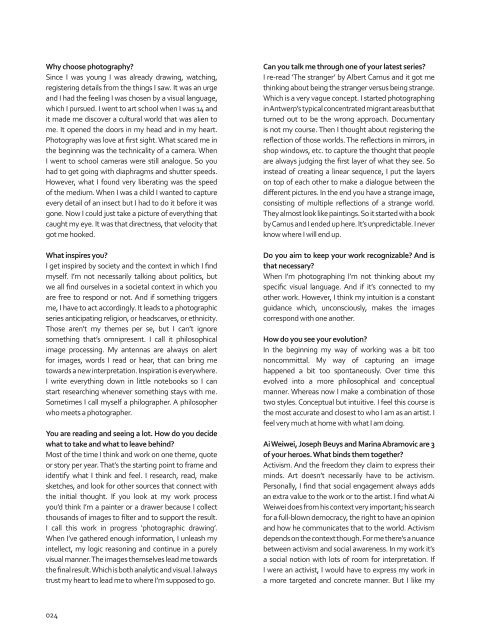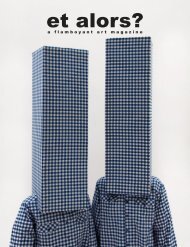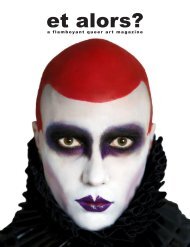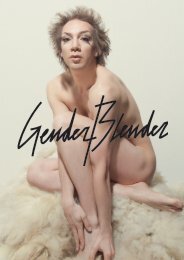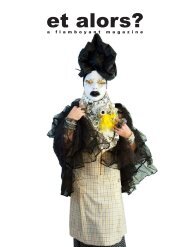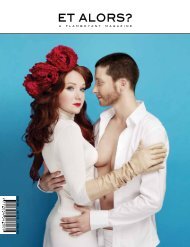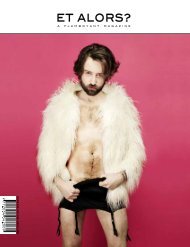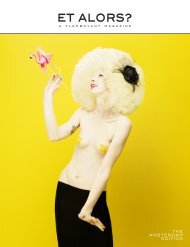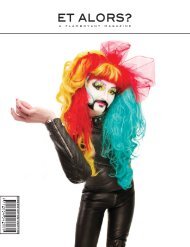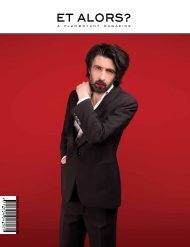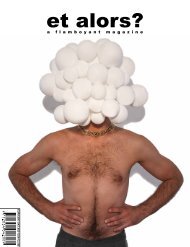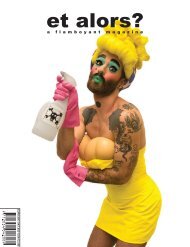Et Alors? Magazine 20
Et Alors? Magazine is a project in motion, co-created by female artist duo and lovers JF. Pierets - Fleur Pierets and Julian P. Boom - who’s work questions the mainstream understandings and the construction of (gay) identity. An ongoing research platform where they publish their conversations with musicians, visual artists, writers and performers by whom they are inspired, hereby capturing the zeitgeist of a world in the midst of its striving for change and it’s cultural awareness when it comes to gay imagery and female representation in mainstream art history. www.etalorsmagazine.com
Et Alors? Magazine is a project in motion, co-created by female artist duo and lovers JF. Pierets - Fleur Pierets and Julian P. Boom - who’s work questions the mainstream understandings and the construction of (gay) identity. An ongoing research platform where they publish their conversations with musicians, visual artists, writers and performers by whom they are inspired, hereby capturing the zeitgeist of a world in the midst of its striving for change and it’s cultural awareness when it comes to gay imagery and female representation in mainstream art history.
www.etalorsmagazine.com
You also want an ePaper? Increase the reach of your titles
YUMPU automatically turns print PDFs into web optimized ePapers that Google loves.
Why choose photography?<br />
Since I was young I was already drawing, watching,<br />
registering details from the things I saw. It was an urge<br />
and I had the feeling I was chosen by a visual language,<br />
which I pursued. I went to art school when I was 14 and<br />
it made me discover a cultural world that was alien to<br />
me. It opened the doors in my head and in my heart.<br />
Photography was love at first sight. What scared me in<br />
the beginning was the technicality of a camera. When<br />
I went to school cameras were still analogue. So you<br />
had to get going with diaphragms and shutter speeds.<br />
However, what I found very liberating was the speed<br />
of the medium. When I was a child I wanted to capture<br />
every detail of an insect but I had to do it before it was<br />
gone. Now I could just take a picture of everything that<br />
caught my eye. It was that directness, that velocity that<br />
got me hooked.<br />
What inspires you?<br />
I get inspired by society and the context in which I find<br />
myself. I’m not necessarily talking about politics, but<br />
we all find ourselves in a societal context in which you<br />
are free to respond or not. And if something triggers<br />
me, I have to act accordingly. It leads to a photographic<br />
series anticipating religion, or headscarves, or ethnicity.<br />
Those aren’t my themes per se, but I can’t ignore<br />
something that’s omnipresent. I call it philosophical<br />
image processing. My antennas are always on alert<br />
for images, words I read or hear, that can bring me<br />
towards a new interpretation. Inspiration is everywhere.<br />
I write everything down in little notebooks so I can<br />
start researching whenever something stays with me.<br />
Sometimes I call myself a philographer. A philosopher<br />
who meets a photographer.<br />
You are reading and seeing a lot. How do you decide<br />
what to take and what to leave behind?<br />
Most of the time I think and work on one theme, quote<br />
or story per year. That’s the starting point to frame and<br />
identify what I think and feel. I research, read, make<br />
sketches, and look for other sources that connect with<br />
the initial thought. If you look at my work process<br />
you’d think I’m a painter or a drawer because I collect<br />
thousands of images to filter and to support the result.<br />
I call this work in progress ‘photographic drawing’.<br />
When I’ve gathered enough information, I unleash my<br />
intellect, my logic reasoning and continue in a purely<br />
visual manner. The images themselves lead me towards<br />
the final result. Which is both analytic and visual. I always<br />
trust my heart to lead me to where I’m supposed to go.<br />
Can you talk me through one of your latest series?<br />
I re-read ‘The stranger’ by Albert Camus and it got me<br />
thinking about being the stranger versus being strange.<br />
Which is a very vague concept. I started photographing<br />
in Antwerp’s typical concentrated migrant areas but that<br />
turned out to be the wrong approach. Documentary<br />
is not my course. Then I thought about registering the<br />
reflection of those worlds. The reflections in mirrors, in<br />
shop windows, etc. to capture the thought that people<br />
are always judging the first layer of what they see. So<br />
instead of creating a linear sequence, I put the layers<br />
on top of each other to make a dialogue between the<br />
different pictures. In the end you have a strange image,<br />
consisting of multiple reflections of a strange world.<br />
They almost look like paintings. So it started with a book<br />
by Camus and I ended up here. It’s unpredictable. I never<br />
know where I will end up.<br />
Do you aim to keep your work recognizable? And is<br />
that necessary?<br />
When I’m photographing I’m not thinking about my<br />
specific visual language. And if it’s connected to my<br />
other work. However, I think my intuition is a constant<br />
guidance which, unconsciously, makes the images<br />
correspond with one another.<br />
How do you see your evolution?<br />
In the beginning my way of working was a bit too<br />
noncommittal. My way of capturing an image<br />
happened a bit too spontaneously. Over time this<br />
evolved into a more philosophical and conceptual<br />
manner. Whereas now I make a combination of those<br />
two styles. Conceptual but intuitive. I feel this course is<br />
the most accurate and closest to who I am as an artist. I<br />
feel very much at home with what I am doing.<br />
Ai Weiwei, Joseph Beuys and Marina Abramovic are 3<br />
of your heroes. What binds them together?<br />
Activism. And the freedom they claim to express their<br />
minds. Art doesn’t necessarily have to be activism.<br />
Personally, I find that social engagement always adds<br />
an extra value to the work or to the artist. I find what Ai<br />
Weiwei does from his context very important; his search<br />
for a full-blown democracy, the right to have an opinion<br />
and how he communicates that to the world. Activism<br />
depends on the context though. For me there’s a nuance<br />
between activism and social awareness. In my work it’s<br />
a social notion with lots of room for interpretation. If<br />
I were an activist, I would have to express my work in<br />
a more targeted and concrete manner. But I like my<br />
024


